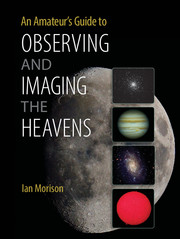Book contents
- Frontmatter
- Dedication
- Contents
- Preface
- Acknowledgements
- Prologue A Tale of Two Scopes
- 1 Telescope and Observing Fundamentals
- 2 Refractors
- 3 Binoculars and Spotting Scopes
- 4 The Newtonian Telescope and Its Derivatives
- 5 The Cassegrain Telescope and Its Derivatives
- 6 Telescope Maintenance, Collimation and Star Testing
- 7 Telescope Accessories
- 8 Telescope Mounts
- 9 The Art of Visual Observing
- 10 Visual Observations of the Moon and Planets
- 11 Imaging the Moon and Planets
- 12 Observing and Imaging the Sun
- 13 Observing and Imaging with an Astro-Video Camera
- 14 DSLR Deep-Sky Imaging
- 15 Imaging with Cooled CCD Cameras
- 16 Auto-Guiding and Drift Scan Alignment
- 17 Spectral Studies
- 18 Improving and Enhancing Images in Photoshop
- Index
- Plate Section
9 - The Art of Visual Observing
Published online by Cambridge University Press: 05 June 2014
- Frontmatter
- Dedication
- Contents
- Preface
- Acknowledgements
- Prologue A Tale of Two Scopes
- 1 Telescope and Observing Fundamentals
- 2 Refractors
- 3 Binoculars and Spotting Scopes
- 4 The Newtonian Telescope and Its Derivatives
- 5 The Cassegrain Telescope and Its Derivatives
- 6 Telescope Maintenance, Collimation and Star Testing
- 7 Telescope Accessories
- 8 Telescope Mounts
- 9 The Art of Visual Observing
- 10 Visual Observations of the Moon and Planets
- 11 Imaging the Moon and Planets
- 12 Observing and Imaging the Sun
- 13 Observing and Imaging with an Astro-Video Camera
- 14 DSLR Deep-Sky Imaging
- 15 Imaging with Cooled CCD Cameras
- 16 Auto-Guiding and Drift Scan Alignment
- 17 Spectral Studies
- 18 Improving and Enhancing Images in Photoshop
- Index
- Plate Section
Summary
The objective of this chapter is to show you how to get the very best out of your visual observing. I think that it is somewhat of a pity that many amateurs have almost given up using their eyes to view the heavens to concentrate on astro-imaging. It’s nice to think that the photons being detected by your retina from M31, the Andromeda Galaxy, left the galaxy some 2.5 million years ago – you are literally looking back in time! There are many images that remain in my memory: the scars on the face of Jupiter as fragments of Showmaker-Levy 9 impacted its surface, the globular cluster M13 appearing almost three dimensional when I first viewed it with my newly constructed 10-inch Dobsonian telescope, the Double Cluster in Perseus when observed with my 12-inch Maksutov and the iridescent green of the Dumbbell Nebula when seen through a 16-inch Schmidt-Cassegrain. But telescopes do not have to be so large to observe some memorable sights: when testing a 5-inch Newtonian from a dark site I was delighted to observe a supernova that had recently occurred in the galaxy M101.
The Eye
We should not forget that the eye is an important part of the imaging chain (see Figure 9.1). Understanding its strengths and weaknesses can help make the best use of its (impressive) abilities. The aspheric lens has a focal length of around 24 mm but, by use of the ciliary muscles, its focal length can be changed to enable the eye to accommodate both near and far distances (at least in young people). The lens has an ‘aperture stop’, the pupil, to help the eye accommodate a range of brightness. Increasing in aperture from ~2 to 7 mm, this can increase the eye’s sensitivity by about 12 times. But, sadly, as we grow older the pupil no longer increases in diameter so much, and 5–5.5 mm may be its maximum. As the collecting area is proportional to the area of the pupil’s diameter, the difference between a 7-mm pupil and a 5-mm pupil is a factor of 2 in area; thus young people may be able to see stars with their unaided eyes which are about two-thirds of a magnitude fainter than those that can be seen by people in their 60s.
- Type
- Chapter
- Information
- An Amateur's Guide to Observing and Imaging the Heavens , pp. 139 - 159Publisher: Cambridge University PressPrint publication year: 2014



